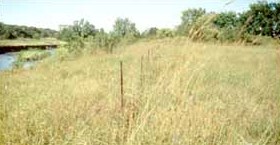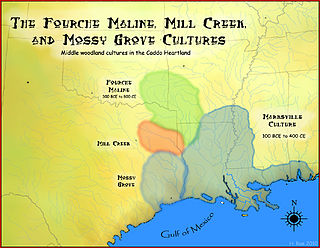Related Research Articles

The Indian Territory and the Indian Territories are terms that generally described an evolving land area set aside by the United States Government for the relocation of Native Americans who held aboriginal title to their land as a sovereign independent state. In general, the tribes ceded land they occupied in exchange for land grants in 1803. The concept of an Indian Territory was an outcome of the US federal government's 18th- and 19th-century policy of Indian removal. After the American Civil War (1861–1865), the policy of the US government was one of assimilation.

The Wichita people or Kitikiti'sh are a confederation of Southern Plains Native American tribes. Historically they spoke the Wichita language and Kichai language, both Caddoan languages. They are indigenous to Oklahoma, Texas, and Kansas.

The Quapaw people are a tribe of Native Americans that coalesced in what is known as the Midwest and Ohio Valley of the present-day United States. The Dhegiha Siouan-speaking tribe historically migrated from the Ohio Valley area to the west side of the Mississippi River and resettled in what is now the state of Arkansas; their name for themselves refers to this migration and to traveling downriver.

El Cuartelejo, or El Quartelejo, is a region in eastern Colorado and western Kansas where Plains Apache cohabited with Puebloans. Subject to religious persecution, Puebloans fled the Spanish Nuevo México territory and cohabitated with the Cuartelejo villagers in the 1600s.

Comanche history is the story of the Native American (Indian) tribe which lived on the Great Plains of the present-day United States. In the 17th century the Eastern Shoshone people who became known as the Comanche migrated southward from Wyoming. In the 18th and 19th centuries the Comanche became the dominant tribe on the southern Great Plains. The Comanche are often characterized as "Lords of the Plains." They presided over a large area called Comancheria which they shared with allied tribes, the Kiowa, Kiowa-Apache, Wichita, and after 1840 the southern Cheyenne and Arapaho. Comanche power and their substantial wealth depended on horses, trading, and raiding. Adroit diplomacy was also a factor in maintaining their dominance and fending off enemies for more than a century. They subsisted on the bison herds of the Plains which they hunted for food and skins.

Spiro Mounds is an archaeological site located in present-day eastern Oklahoma that remains from an indigenous Indian culture that was part of the major northern Caddoan Mississippian culture. The 80-acre site is located within a floodplain on the southern side of the Arkansas River. The modern town of Spiro developed approximately seven miles to the south.
Jean-Baptiste Bénard de la Harpe was a French explorer who is credited with the discovery of Little Rock, Arkansas. He was the first known French explorer to set foot in the future state of Oklahoma.

Indian Village State Preserve, or the Wittrock Indian Village State Preserve, is a state archaeological preserve near Sutherland, Iowa. The 6-acre (2.4 ha) property preserves the Indian Village Site (13OB4), a prehistoric fortified village of the Mill Creek culture. It was declared a National Historic Landmark in 1964, and made a state preserve in 1968. It is located east of Sutherland, south of 455th Street and west of Yellow Avenue. Access to the preserve requires crossing private land.

Leary Site, also known as 25-RH-1 or Leary-Kelly Site is an archaeological site near Rulo, Nebraska and the Big Nemaha River. The site now lies entirely on the reservation of the Iowa Tribe of Kansas and Nebraska. The area was once a village and burial site.

The Pike-Pawnee Village Site, or Hill Farm Site, designated 25WT1 by archaeologists, is a site near the village of Guide Rock in Webster County, in the south central portion of the state of Nebraska, in the Great Plains region of the United States. It was the location of a village of the Kitkehahki band of the Pawnee people, in a region of the Republican River valley that they occupied intermittently from the 1770s to the 1820s.

The Osage Village State Historic Site is a publicly owned property in Vernon County, Missouri, maintained by the Missouri Department of Natural Resources. The historic site preserves the archaeological site of a major Osage village, that once had some 200 lodges housing 2,000 to 3,000 people. The site, designated by the Smithsonian trinomial 23VE01, was also known for many years as the Carrington Osage Village Site, under which name it was designated a National Historic Landmark in 1964.

The Fourche Maline culture was a Woodland Period Native American culture that existed from 300 BCE to 800 CE, in what are now defined as southeastern Oklahoma, southwestern Arkansas, northwestern Louisiana, and northeastern Texas. They are considered to be one of the main ancestral groups of the Caddoan Mississippian culture, along with the contemporaneous Mill Creek culture of eastern Texas. This culture was named for the Fourche Maline Creek, a tributary of the Poteau River. Their modern descendants are the Caddo Nation of Oklahoma.

Etzanoa is a historical city of the Wichita people, located in present-day Arkansas City, Kansas, near the Arkansas River, that flourished between 1450 and 1700. Dubbed "the Great Settlement" by Spanish explorers who visited the site, Etzanoa may have housed 20,000 Wichita people. The historical city is considered part of Quivira.
Claude Charles Du Tisné led the first official French expedition to visit the Osage and the Wichita Indians in 1719 in what became known as Kansas in the present-day United States.
The Taovaya tribe of the Wichita people were Native Americans originally from Kansas, who moved south into Oklahoma and Texas in the 18th century. They spoke the Taovaya dialect of the Wichita language, a Caddoan language. Taovaya people today are enrolled in the Wichita and Affiliated Tribes, a federally recognized tribe headquartered in Anadarko, Oklahoma.
The Dismal River culture refers to a set of cultural attributes first seen in the Dismal River area of Nebraska in the 1930s by archaeologists William Duncan Strong, Waldo Rudolph Wedel and A. T. Hill. Also known as Dismal River aspect and Dismal River complex, dated between 1650-1750 A.D., is different from other prehistoric Central Plains and Woodland traditions of the western Plains. The Dismal River people are believed to have spoken an Athabascan language and to have been part of the people later known to Europeans as Apaches.
Pierre Antoine and Paul Mallet, brothers and French Canadian voyageurs, were the first Europeans known to have crossed the Great Plains from east to west. They first journeyed to Santa Fe, New Mexico from Kaskaskia, Illinois in 1739.
The Battle of the Two Villages was a Spanish attack on Taovaya villages in Texas and Oklahoma by a Spanish army in 1759. The Spanish were defeated by the Taovaya and other Wichita tribes with assistance from the Comanche.

The Southern Plains villagers were semi-sedentary Native Americans who lived on the Great Plains in western Oklahoma, Texas, Kansas, and southeastern Colorado from about AD 800 until AD 1500.

The Moccasin Bluff site is an archaeological site located along the Red Bud Trail and the St. Joseph River north of Buchanan, Michigan. It was listed on the National Register of Historic Places in 1977, and has been classified as a multi-component prehistoric site with the major component dating to the Late Woodland/Upper Mississippian period.
References
- 1 2 O'Dell, Larry. "Deer Creek Site." Oklahoma Historical Society's Encyclopedia of Oklahoma History and Cultural. (retrieved 28 Nov 2009)
- ↑ "National Register Information System". National Register of Historic Places . National Park Service. January 23, 2007.
- 1 2 "Deer Creek Site". National Historic Landmark summary listing. National Park Service. Archived from the original on 2009-12-14. Retrieved 2008-01-18.
- 1 2 3 http://www.tulsaworld.com/NewStory.asp?ID=070108_Ne_a13_Diggi26796 . Retrieved 2010-08-05.
{{cite web}}: Missing or empty|title=(help) - ↑ "OAS -- Oklahoma's Past". Archived from the original on 2010-12-21. Retrieved 2010-12-25.
- ↑ Leith, Elizabeth A. "European Trade Goods on the Southern Plains: The Bryson-Paddock and Deer Creek Sites". Plains Anthropologist. Vol. 53, No 208, 2008, pp. 551-564
- ↑ "Wichita Tribe - Access Genealogy". 9 July 2011. Retrieved 20 August 2018.
- ↑ Hamalainen, Pekka The Comanche Empire New Haven: Yale U Press, 2005, pp. 91-93
- 1 2 O'Dell
- ↑ "Wichita-French Early Historic Contact Site". Archived from the original on 2010-06-02. Retrieved 2010-08-06.